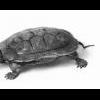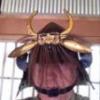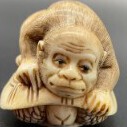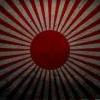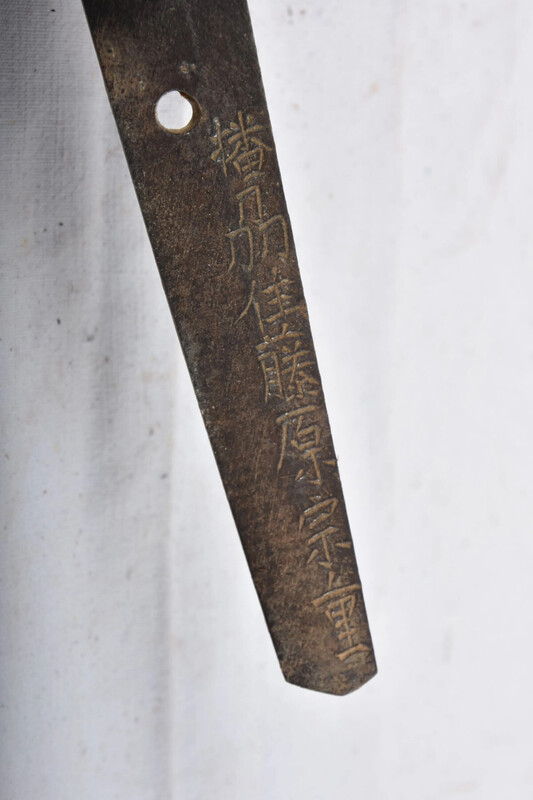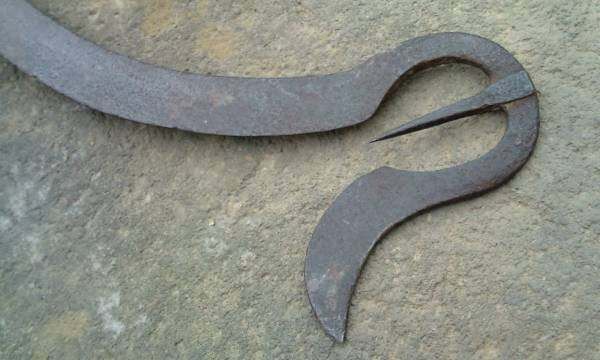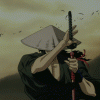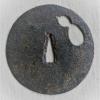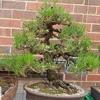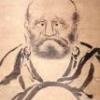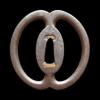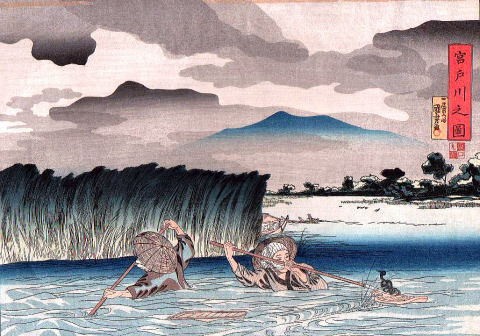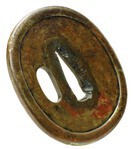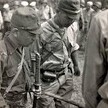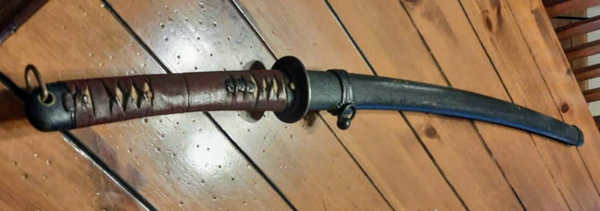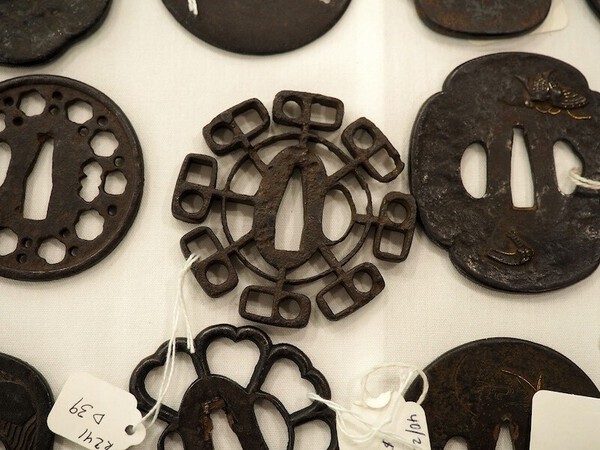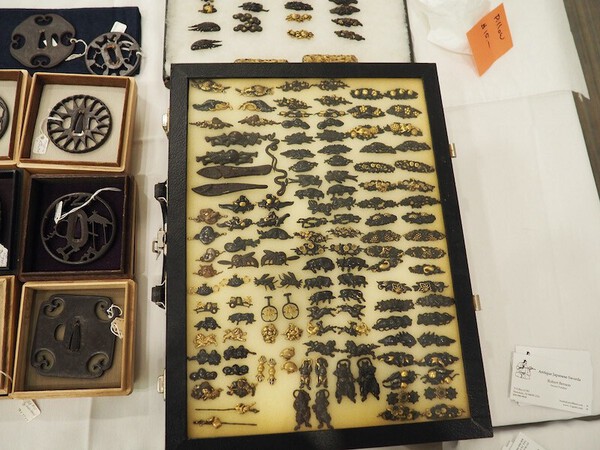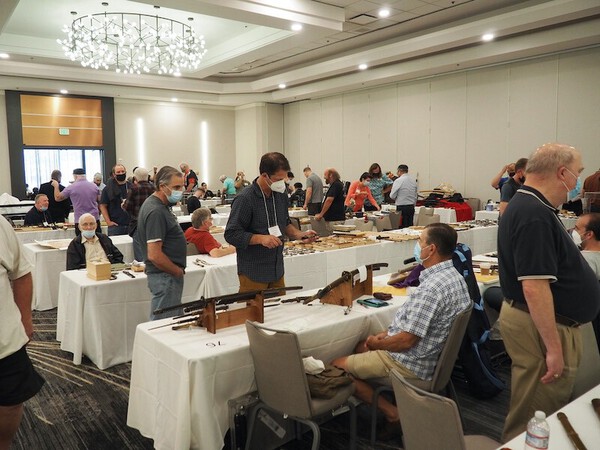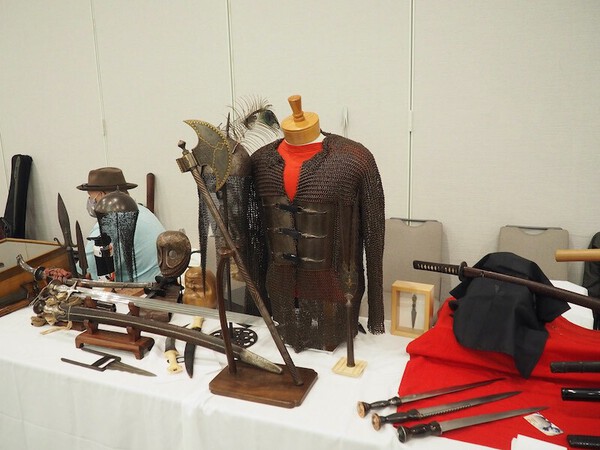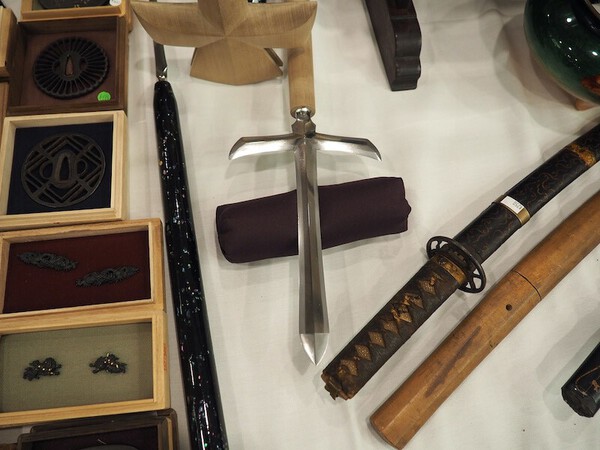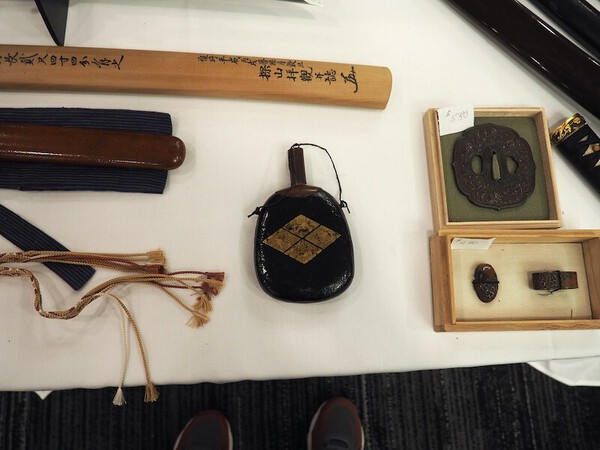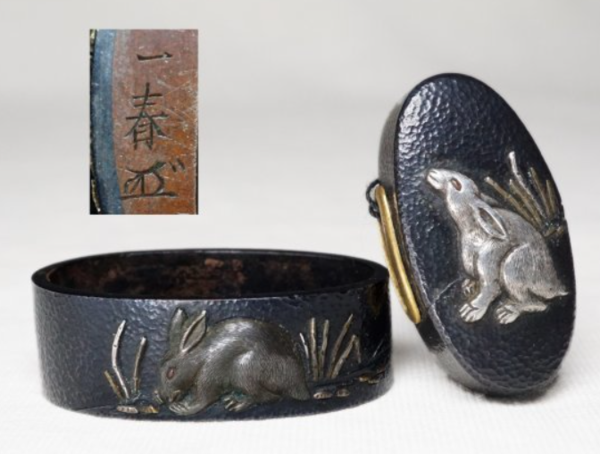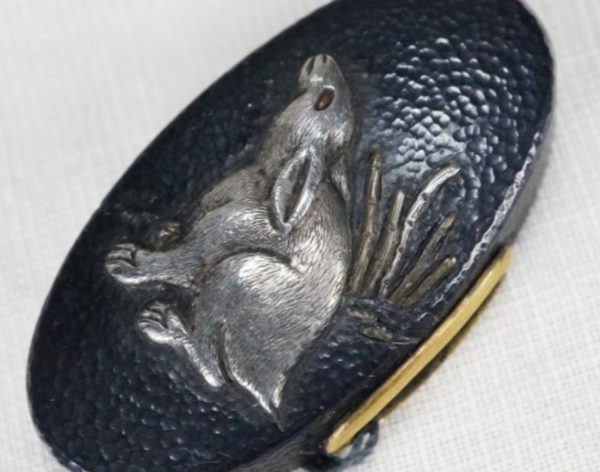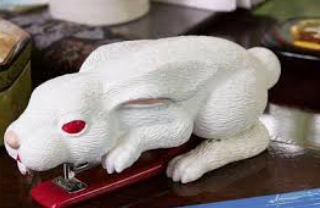Leaderboard
Popular Content
Showing content with the highest reputation on 11/02/2021 in all areas
-
I received some flak recently from the popcorn gallery about a statement I made previously about the horimono being the most essential element in an Ikkanshi Tadatsuna. A few interesting examples came up recently that confirmed what I've been saying (I mean, I do not pull this kind of statement out of my butt... I am told this kind of thing by people like Tanobe sensei and Kurokawa san and then it's verified in the marketplace, I don't tend to go around making things up though that claim is often made). Anyway Aoi has a fine Tadatsuna wakizashi on their site now: https://www.aoijapan.com/wakizashiawataguchi-ikkanshi-tadatsuna-hori-do-saku/ And this blade is actually short even for a wak, 46 cm... but it features good horimono by the smith along with his attestation that he made the horimono. Tadatsuna almost need to be looked at as buying a horimono with a sword as a frame. You don't want a junk sword but getting yourself bent out of shape on the sword or buying one that is long and nice without horimono misses the point. Aoi has sold blades like that in the 2.6-2.8M yen in the past, good long katana but lacking the horimono. This example entirely agrees with what I've said in my blog where I highlight which might be his master work which is only 63 cm... many longer examples exist but that one has the best horimono of them all. If you took the time to look through the Dai Token Ichi catalog you will find another Tadatsuna, and the way the dealer featured the listing, they didn't even bother to show the sugata of the blade. Rather, they made a point to highlight the horimono and nakago indicating that the smith made the horimono himself. So the sugata is basically relatively unimportant compared to these other elements when it comes to this smith, so much so that it's not even used in advertising this particular blade. Understanding these things, understanding what makes a certain smith special and precious, and then so what metrics apply to that smith, or that school, or that period in terms of separating the wheat from the chaff is extremely important for both dealers and for collectors. Otherwise as a collector you pat yourself on the back for buying a "cheap" example but the reason it was cheap is because the market is efficient: it is lacking the features that would make it more expensive and you may be ignorant of what those features are. Like a coin collector who knows the ins and outs, the rare years or weird kinds of marks that may appear on just a very few coins, they've studied all of the subject matter and know which elements are those that separate the most collectible from the least. And so those metrics have a direct bearing on the price. With Tsuda Sukehiro a shorthand can be found in the signature. Those signed Echizen no Kami Sukehiro, are superceded by those signed Tsuda Echizen no Kami Sukehiro, and those in turn superceded by those done with round grass script in the mei, those are called in dealer circles "maru Tsuda." These form a rule of thumb. A certain example from the first type can pass Juyo and a certain example of the last type may not pass Juyo, but people who try to make statistical conclusions from one item are falling into a fallacy of anecdotal evidence. The groups, taken as groups, are partitioned into generally better work as the mei evolves, the mei evolves along with Sukehiro's experience and development as a swordsmith. So this information is NOT why the blade becomes more valuable, but it happens in the case of this smith to be a handy indicator of when in his career it was made and so what the skill level of the maker was at the time. It just parallels his development. When a dealer comes and a customer doesn't understand the difference the dealer can conflate it all together and say well this one signed like this is a bargain because the average price of Sukehiro is higher... but the average price of Sukehiro is higher because in general a blade signed that way in the example the dealer is pushing is falling into a lesser category. Again, standout examples exist and that's why you should study and know what you see, but dealers who buy on the one hand with advanced metrics and then turn around and say "hogwash" when they sell are engaging in a form of ignorance arbitrage. They are buying in an informed market and selling in an uninformed market, and that allows there to be profit. Nobody should be telling you the horimono of a Tadatsuna is not an important part or less than the most significant part of the blade. A well preserved and excellently executed horimono is what we seek in this blade, along with the smith's attestation that he made it. This of course is the precise reason that makes that aspect of these works a target for fakery. Because the guys faking it tend to know how important it is, and even their attempt to fake it might go over the heads of people who are buying simply on length.7 points
-
I somewhat expect that the amount of new information, the growing scarcity, the inflation of anything that is a store of wealth, the new trend for dedicated 95 collectors have all eaten up supply and increased prices. I don't see them ever going down again. They are the easiest military Japanese swords to collect. From a price point, from a knowledge point and from the fact that you can complete a set within a couple of hard years of looking. That is all why I collect them, amongst other reasons.5 points
-
My opinion is that you should not modify antique blades to suit your aesthetics. There are modern swords you can do that with. If it is shinshinto period, leave it be. Restore it and leave it. Now we have a thread here on the board encouraging this behavior. Why does it modify the sugata? When the hamon expands the mune goes into tension. The hamon pushes back on the extremes of the blade and this creates the curve. The mune and shinogi-ji are the part of the sword that resists this pressure. This pre-stressing helps the sword keep its shape. Now you go and cut out a bunch of the meat that was doing the resisting, so there is less there to resist. As a result the hamon is able to more overpower the mune and the sugata changes. The pressure in the ha is released somewhat as well and the blade is going to have new characteristics after the hi goes in.4 points
-
That is correct Vincent. 播磨 Harima (now in Hyōgo) starts with that Kanji that can also be read ‘Ban’. The second Kanji is an old variant for 州 Shū or province. (I have noticed these three 刀 used for Shū in the Ōsaka area before. I wonder if it was a geographical thing?)3 points
-
Coming up to midday here on the 2nd of November, so 36 hours, or a day and a half left before Japan hits midnight on 3 November. NB In case people wonder why I am doing this, I may have mentioned before that Brian has cut me some serious slack in the past. I do not have a lot of spare cash and my PayPal is broken anyway, so it seemed like another fun way to repay his kindness and support the NMB.2 points
-
My first foray into a lone koshirae and fittings and went out on a limb purchasing a Wakizashi koshirae (no tsuba and some missing inlays) because honestly I like the look of it and do have a blade that would be a great upgrade for it if all the stars align to have it fit. A Google search didn't provide anything on Matsuyama Junin TOSHINOBU whom signed the koshirae. I also ended up getting a Kozuka lot (one will just be a shelf or inside drawer decoration) to work towards completing some Koshirae I already have I would classify these as "beginner" pieces, and you get what you pay for, but thought I'd share a humble little haul and of course always open to hear thoughts/feedback and if anyone knows the koshirae artist that would be amazing. *the photos got uploaded in a weird order but koshirae description is in between kozuka images.1 point
-
https://www.sothebys.com/en/buy/auction/2021/the-samurai-Japanese-arms-and-armour-2 Disclaimer, I have a few things in this.1 point
-
1 point
-
1 point
-
It's worth remembering just how many swords there were and are in Japan. Also a good maker does not mean that a good sword was used, most likely damaged blades. Anything saleable would have gone to market.1 point
-
Adam, there I feel also addressed, since I criticized the sword quite. But there is nothing to regret! Even if my best friend would have been extremely interested in this sword, I could not have recommended it with a clear conscience if he had asked me for my opinion. You can find the reasoning in my response at the time above. Ken is right, think about what you really want. After all, an o-kissaki still includes the rest of the sword. The development of the nanbokucho sugata in katana parallels the development of the soshu den. The Sugata change can be seen very well in Masamune blades. His disciples not only spread the Soshu characteristics in Japan, but concomitantly spread the typical Sugata, which peaked between 1340 to 1370. Other traditions also adopted the Sugata independently to at least some extent. Besides this origin, the most important renaissances of this style occurred during Tensho/Keicho, in Shinshinto, and in Gendai with a focus on Soden-Bizen and Kiyomaro-Utsushi. But also in between the style appears again and again. If I see a blade with typical Nanbokucho sugata that is not original to the period, I consider the extent to which the swordsmith is addressing the utsushi of a particular school in addition to the utsushi of the form. Can I see characteristics of Shizu, or Kinju, Hasebe, Sa, Soden-Bizen? Here is an example: https://www.nipponto.co.jp/swords7/NT331311.htm A rather short katana. Although some mune-fumbari can be seen, the shape fits to imitate O-Suriage Nanbokucho. But according to the dimensions of the Moto and Sakihaba, it remains an impressive and proud appearance. The strong kasane is typical of the time and would be too strong for an O-Suriage at this point of the blade. Sadakiyo is not among the top of Hojoji swordsmiths, but from personal experience I can say that many Hojoji smiths have worked to a very uniformly high standard of quality. This can be seen here. Hada is really typical of Edo-Hojoji. The quality of the deki is right for hojoji. Perhaps the interspersed ko-gunome is a bit too "excited" for this school, but it is also not unusual, and it fits the overall concept of a Nanbokucho utsushi, if Sadakiyo wanted to imitate Naoe Shizu. The nioiguchi is even and controlled, and the blade appears quite healthy. A nanbokucho utsushi would not really be typical of the period around Enpo. If the trend of sugata is not really in line with the taste of the time, it is very likely that the sword was purposefully requested that way by the customer. Possibly as a direct copy of an old sword owned by the client. No, the blade has no paper and the signature would have to be checked, but from the features of the blade I would not doubt Edo-Hojoji. It's a nice and solid blade. This is what I mean: proceed like a pilot before taking off his plane. check if everything is coherent and fits. The more you learn, the more your view widens and at the same time focuses on very essential and important aspects. This also includes recognizing, appreciating and enjoying the quality of swords that you do not own, or (also financially) can never own. If you go this way, you are more likely to regret buying a sword that at first glance is an impressive weapon, but on closer inspection does not fulfill you. Your budget is very tight, you will probably have to expand it. But it is not impossible to find something suitable that will give you lasting pleasure. Excuse my bad english!1 point
-
1 point
-
1 point
-
No Darcy. The sword is a shinsakuto used by him just for sport. Therefore modifying it to suit him is perfectly ok. It isn't a Shinshinto. No-one here advocated doing this to swords of any age. Cutting hi into an antique would be condemned by just about every member here, since we constantly have a go at people using antique swords for martial arts.1 point
-
Hello Scott, In a general sense, I have to voice my concern with your statement about where to go for Nihonto value assessment. Generally speaking...Ebay & Auction houses are not a good barometer for value. A lot of merchandise on Ebay is incorrectly/falsely advertised, and auction houses may or may not have in-depth knowledge of all the items being sold. Ebay & Auction houses often end up with final sales amounts that are inconsistent with true values, there are folks that in the heat of the moment, who end up bidding $5000 for an item, only to find out after the fact that it is a modern replica or inaccurately advertised. While others bid $500 and end up with a treasure. Neither result reflects an accurate portrayal of the actual real value of the item. My .02 worth Mark1 point
-
1 point
-
1 point
-
Saya colour is great, there are a huge range of shade of brown and green. The patina is what tells you if it is a repaint. On a side note, I have a copper that has three distinct layers of greens in the little paint that remains. I assume arsenal refurbishment is always a possibility. As to the habaki, that happens. I have a couple of swords that are similarly a less than ideal fit. Not a lot to be done I'm afraid.1 point
-
Per Sesko, there was a Tsugunobu (継延) who was a smith from Gunma who studied under Kasama Shigetsugu. He was a Rikugun Jumei Tosho smith who initially signed Kaneharu. If the same smith, this may be a very nice gendaito. Best regards, Ray1 point
-
Welcome Glen, to the NMB! If your blade is more than 606 mm in length, it is a TACHI (not KATANA) in this case. The signature is on the outside of the tang when worn in military mounts. If you are not familiar with these blades, please read here on the NMB about handling and care, so you may preserve the blade (and its value) for future generations. Please show it also in the Military section, the experts there will tell you more about the smith and if it could perhaps be a traditionally made one.1 point
-
高崎住藤原継延作 - Takasaki ju Fujiwara Tsugunobu saku 昭和十七年一月日 - A day in the first month of 1942 (Showa 17)1 point
-
1 point
-
1 point
-
I wouldn't bother. A Hozon paper will catalog and describe the parts physically, but give you very little useful data that is new. While green papers are often frowned on or dismissed for verifying signatures on fittings, green papers that prove your koshirae was around 40+ years ago are actually good enough proof for me that it isn't a modern construct or replica. It is one of those rare instances where I think keeping the green papers actually makes sense and might be even slightly advantageous. All that mailing to Japan, agent fees, time, costs, etc... Lot of hassle for little gain on most koshirae. Grey's advice was spot on.1 point
-
Hi Russ, There's not much I can tell you from those photos that you haven't spotted. It's genuine but the blade is pretty featureless, the only bits that stand out for me are what look like a couple of rust pits and possibly a fukure. The shitodome is missing from the scabbard and the metal fittings are rusty. I agree with Ken that it is overpriced for what it is - an unsigned blade of average workmanship, maybe shinshinto era, and both blade and fittings not in best condition. My advice would be to keep your money and wait for something better to come along as I feel you'll struggle to get your money back or very much enjoyment from owning the blade. If you feel that you have to have it view it in hand if you can to make sure there's nothing not visible in the photos, and try making a low offer, maybe around $500 to $600 and see where that leads you.1 point
-
It's more than what I would pay, Russ, but it is a real Nihonto. Check out https://markussesko.com/2015/04/13/kantei-1-sugata-7/ so you can make your own educated decision.1 point
-
1 point
-
Mike - the 200 item limit is just what it takes to break-even (here in the U.S.) - you wouldn't have to guarantee that number but it would go a long way to convincing the team it is worthwhile - it is extremely hard to get folks to commit early, we always had walk-ins and late adds, these play havoc with the schedulling but in the end are welcome as they always put us over the top. -t I will be talking to Professor Robson this weekend and will see what he is thinking...1 point
-
Some interesting comments, so i thought i'd add to the mix. I believe the current market value for these is $750 to $1300, obviously the minty ones are at the higher end. This is from actual Auctions if you consider fleabay only. The ones in this range seem to be moving, there are sellers who shoot over the mark but have the 'make an offer' option, these take a little longer, sometimes even months, but eventually sell to an agreed offer. Lastly there are the dreamers, they shoot at the stars when aiming for the moon. It is like they have been hit with a high greed factor and will not budge, others tend to join in also asking some ridiculous prices. Just like Real Estate agents, these sellers are the ones who are 'artificially' driving the prices up. These tend to remain unsold for many months if not nearly years Don't get me wrong, pristine/unique examples will always command a higher price due to demand, so you get some selling at higher than normal prices. Currently, there are some average swords being offered at (what i consider to be), very high 'fixed' prices. On the same note, some very nice pieces are going to auction at low starts and reasonable finish prices. If i was looking to buy, these are the ones i would be looking at. Don't forget that there are other sources to get these from, Fleabay is not your only option.1 point
-
1 point
-
John, I agree, but if Japan ever makes these legal to own the price will go way up. Younger Japanese don't seem to feel the same stigma as the older ones. This is true of younger Germans and Europeans as well (on WW2 German items), but still taboo. From my experience the vast majority are not Nazi's. To them it's just history. There is a BIG difference between having a private collection (and not being a nazi) and marching down the street with a nazi flag. JMHO Regards, Corry1 point
-
1 point
-
Geoff, I knew I had seen a drawing of the original RS. Nick Komiya re-posted for me. It shows the tassel tied through the hole in the kabutogane. Now, we know that Officers (and enlisted) personalized their stuff often, and it would not surprise me to find that several had sarute added to their gunto. Nick's post: https://www.warrelics.eu/forum/f216/unveiling-rinjiseishiki-sword-1940-a-793016-post2194291/#post21942911 point
-
1 point
-
G'day all, I've decided to drop the price a bit and it is still negotiable. I need to sell as quickly as possible so this is a good time to invest in an awesome mukansa sword. Price now $5500USD Don't forget that NMB members get free worldwide shipping!1 point
-
0 points
-
0 points
-
And because you are just generally an all around nice guy. I can verify that0 points
-
@Bruce Pennington, I think the local variation now reads: "And they shall beat their swords into plowshares; and if any of those swords are nihonto, there will be a wailing and a gnashing of teeth on the NMB. And there shall be a plague of sad-emoji responses and down-voting of the beaters of swords"0 points
This leaderboard is set to Johannesburg/GMT+02:00

